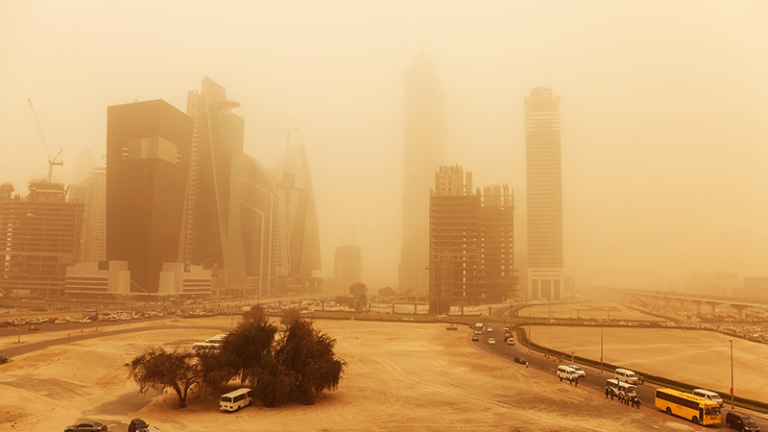
The cities of the Arabian Gulf are presented as the epitome of the hypermodern urban environment. Skyscrapers made of concrete, steel, and glass shimmer in the desert sun, while careful urban planning seamlessly moves residents between climate-controlled buildings, untroubled by the heat outside. This vision of the 21st century city-in-the-desert is dramatically disrupted—and its sustainability brought into question—by the phenomenon of sand and dust storms (SDS). Such storms turn cities a murky brown and dramatically reduce visibility, placing them in sharp conflict with the visual aesthetics of Gulf urbanism. In addition, abrasive sand particles lodge in air conditioning units and car engines, and often ground both commercial and cargo flights, thereby disrupting the very functioning of everyday life. For all the disruption caused by this force majeure, much about SDS, including how to mitigate the phenomenon’s effects, remains poorly understood and has received relatively little scientific or policy attention. Considering the growing prevalence of SDS across the Middle East and North Africa, the storms’ impact on health, society, and the economy must surely be addressed, and policies need to be instituted to alleviate their effects.
Sand and Dust Storms in the Middle East and North Africa
SDS occur in arid and semi-arid areas when winds blow across dry and loose sand and dirt, kicking particles into the air and keeping them suspended. Wind turbulence then carries the particles, with particle size dictating both the distance they are transported and how far above the ground they float. This weather phenomenon plays an important ecological role, as it works to replenish soil with nutrient-rich sediment, even in areas far from the origins of the storms. For example, Western Saharan dust makes it all the way to the Amazon rainforest, providing plants with much-needed iron and phosphate. But while such atmospheric processes certainly offer benefits to some locations, they also remove topsoil from other sites and contribute to desertification and soil loss.
Sand and dust storms occur predominantly in the spring and summer months in the Levant and Gulf regions.
SDS occur predominantly in the spring and summer months in the Levant and Gulf regions, and follow six storm paths across the region. The most common paths are the shamal winds that blow across Syria, Iraq, and the Gulf states, and the khamsin winds in North Africa, which come up from the south or southeast during the winter and early spring, bringing particulate matter from the Sahara to the Mediterranean.
The exact causes of SDS remain uncertain, but they are almost certainly due to a complex combination of interdependent natural and anthropogenic factors. And because their causes are unknown, many simply throw up their hands and label the storms an ungovernable natural phenomenon that is beyond the reach of government policy and intervention. Nevertheless, the Intergovernmental Panel on Climate Change (IPCC) notes that, “The frequency and intensity of dust storms have increased over the last few decades due to land use and land cover changes.” And in recent years there have been moves to place sand and dust storms on the environmental agenda. Former Executive Director of the UN Environment Program Erik Solheim, for example, has called for a prioritization of SDS at the 2022 and 2023 United Nations Climate Change Conferences, saying that, “Sand and dust storms have hardly been talked about in climate talks.”
Damage, Disruptions, and Health Risks
SDS present significant dangers and disruptions for humans and their environment. The World Meteorological Organization notes that SDS present a significant health risk, especially to the young and elderly, and can cause skin and eye irritation, as well as respiratory disorders such as asthma, tracheitis, and pneumonia. Finer particles can also enter the blood stream and are sometimes responsible for cardiovascular disorders. In addition, particles can transport microorganisms like bacteria and viruses, making SDS a possible contributing factor in the incidence of epidemics in the Sahel region.
SDS present a significant health risk, especially to the young and elderly, and can cause skin and eye irritation, as well as respiratory disorders such as asthma, tracheitis, and pneumonia.
In addition to health risks, SDS also result in significant economic costs, with the World Bank estimating that SDS cost the MENA region over $150 billion annually, which includes damage to residential and commercial buildings, crop losses, and disruptions in power, water, and transportation infrastructure. As with other climate change-induced weather events, the effects of SDS encourage behavior that further contributes to climate change, such as the use of pressure washing to remove sediment from cars and buildings, which further exacerbates water shortages.
One sector that is significantly affected by SDS is solar power. The output of both photovoltaic (PV) and concentrating solar-thermal power (CSP) systems are affected during SDS events, which reduce the intensity of solar radiation reaching the solar converters by soiling the panels’ reflective surfaces. Particles can cause also surface abrasions to the glass used in solar panels, reducing their reflectiveness and thereby also reducing their energy generating capacity. Regularly washing the panels is an obvious, if only partial, fix for this problem, but with water resources in the MENA region unreliable and often unavailable, this may not be a sustainable solution.
Mitigation and Adaptation in Iraq and the Gulf States
Iraq plays a central role in the regional system of storms and particle transportation, with the Tigris and Euphrates floodplains providing a major source of sediment. In recent years, topsoil fragility has increased due to both a 50 percent decrease in precipitation and higher evaporation rates. As a result, the UN Environment Program has labeled Iraq as highly vulnerable to climate change and desertification. And as Iraq’s own environmental ministry has noted, over the past two decades the country has experienced a notable increase in the number of days with SDS, from 243 to 272 days a year. In addition, whereas storms used to occur during specific seasons, they now increasingly happen throughout the year.
Scholar Varoujan Sissakian suggests that SDS events in Iraq are exacerbated by “inappropriate farming practice, mismanagement of water resources, and climate change.” Moreover, the building of dams in Turkey, Iran, and Syria, which has decreased water flow in the Tigris and Euphrates rivers, and the draining of the Mesopotamian marshes in the 1950s, have reduced vegetation cover and contributed to desertification. Further exacerbating the issue, the Iran–Iraq War, the Gulf War, the US invasion, and the rise the Islamic State in Iraq and Syria have all left the country’s government and economy vulnerable to external shocks and lacking the civic, economic, and political networks necessary to deal with challenges as complex and multifaceted as SDS and climate change.
The building of dams in Turkey, Iran, and Syria, which has decreased water flow in the Tigris and Euphrates rivers, and the draining of the Mesopotamian marshes in the 1950s, have reduced vegetation cover and contributed to desertification.
One proposed solution to help mitigate the effects of SDS is to build green belts around urban settlements, which would help stabilize soils and thereby reduce the movement of sand and dust. In Iraq, such an effort could include the rehabilitation of Iraq’s historic date palm groves, the extent and upkeep of which were significantly reduced due to Baath Party policies in the 1990s, and to the 2003 invasion.
In 2006, a plan was proposed to plant eucalyptus trees, olive groves, and date palms as a protective green crescent around the city of Karbala in central Iraq. Sixteen years later, only a fraction of the proposed crescent has been planted, and those areas that have been established suffer from poor irrigation and maintenance. The initiative ultimately fell victim to a lack of political will among a wide range of local and state authorities, and to endemic corruption. It thus stands as a reminder of the need for ecological projects to be well funded and to involve both coordination across ministries and support from robust governmental legislation.
Nevertheless, there are some signs that the Iraqi government is looking to build resilience measures to combat SDS. It will be interesting to see whether Iraq can successfully demonstrate how climate transitions might be made to align with and help bolster post-conflict reconstruction. Going forward, it will be necessary for the Iraqi government to place SDS mitigation and adaptation at the heart of its environmental policy, and to take into account how such policy impacts everything from agricultural development to water management and urban planning.
Compared to Iraq, Gulf states possesses superior economic and technological capabilities to tackle SDS, which at first blush appears to allow them to easily mitigate the impact of sand encroachment. For instance, in 2021, Saudi Arabia’s Crown Prince Mohammed bin Salman announced the Saudi Green Initiative and the related Middle East Green Initiative to plant 50 billion trees across the region—by far the world’s biggest afforestation project. Meanwhile, the UAE has invested in new technology, including a real-time dust storm forecasting system, to help the country better equip itself for potential storms. All of this demonstrates the substantial gap between Iraq and the oil-rich Gulf states’ respective capacities to address the issue. As geopolitical consultant Banafsheh Keynoush has argued, while Saudi Arabia “has invested several billion dollars in green belts to protect against many environmental issues,” in Iraq “money is lacking, and conflict is pervasive. Water scarcity due to conflicts and conflicts due to water scarcity are on the rise. The challenges…seem insurmountable.”
But despite the Gulf countries’ substantial resources, national policy alone will not offer sufficient SDS mitigation. Because SDS are transnational phenomena, policies for adaptation and mitigation must involve regional cooperation. There are indeed some indications that a regionally-focused policy is beginning to be implemented. Alongside the Middle East Green Initiative, a joint project established in 2021 between the Kuwait Fund for Arab Economic Development, the Kuwait Institute for Scientific Research, and the Iraqi Ministry of Agriculture aims to mitigate the effects of SDS in the governorates of Muthanna and Dhi Qar in southern Iraq. While this project is limited in scope and its results have yet to be seen, it does point to a growing awareness that SDS necessitate regional planning at a scale that matches that of SDS systems themselves.
Action on All Fronts
The upcoming 2022 and 2023 UN Climate Change Conferences present an opportunity to recenter the climate change agenda so that it speaks to and engages with the Middle East and North Africa, a region that faces clear and immediate climate change threats. Central to this should be placing SDS higher on the climate change agenda, both in terms of scientific research on the phenomenon and the development of effective mitigation and adaptation strategies. SDS challenge our understanding of climate disasters, demonstrating the linkages between the local, national, regional, and global levels that together make up climate and ecological systems. Only through climate change policies that successfully travel between these different levels and scales of operation will it be possible to build resilience to future climate stresses.

